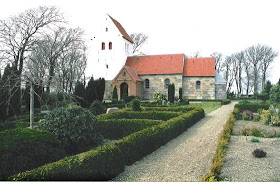
Tøndering Church, ab.20 km north of Skive

Tøndering Church is placed in the middle part of North Salling at the village Tøndering west of the manor Hegnet. Choir and apse are Romanesque with a late Gothic tower, while the porch is from 1871. The original Romanesque building is granite ashlars. The apse window is preserved and a bricked-up window in the nave. Above the south door is a rundstavs- (round staved) framed thympanum field. The original choir arch with profiled kragsten (oblong relief stone) is preserved - and in the north wall of the choir are placed four "lydpotter" (sounding pots). The tower is built in ashlars, raw boulder and monk bricks. A high freestanding stair on the north side gives access to the middle storey. The tower room has a cross vault and a large round arch to the nave.
The communion table panel is new, while the altar piece is Renaissance with a painting of the Holy communion. The altar candelabres are from the 1600s with engraved initials IPS. The pulpit is Renaissance with paintings of the Evangelists and an ornament from 1709. A medieval Mary-figure has disappeared in recent times. The large Romanesque granite font has a smooth basin. The baptismal basin is of a Netherland type from 1633. In the northern wall of the nave is a grave stone with portraits of Anders Skeel of Hegnet, (+1558) and his two wives, fru Karen Flemming and fru Bege Rosenkrantz. Upon the church yard is a Romanesque grave stone with a cross.


Anders Skeel of Hegnet and his two wives & the simple Romanesque granite font.
Hegnet Manor
The manor Hegnet belonged to Bugge Nielsen Bugge ab. 1330. Fru Bolde of Hegnet is mentioned in a letter from 1471. Her sister Kirsten's granddaughter Kirsten Nielsdatter Krag was married to Peder Hase of Vellumgård, and her second husband was Anders Skeel (+ ab. 1455), who owned Hegnet in 1443. His son, Albert Skeel is the owner of Hegnet 1471-1500, after that it belonged to his son Anders Skeel (+1558) and his sons Jacob Skeel (+1565) and Albert Skeel (+1568). Hegnet came to Albert Skeel's (+1568) son, rigsråd Christen Skeel (+1595) and his children rigsmarsk hr. Jørgen Skeel (+1631) and rigsadmiral hr. Manderup Due (Taube) (+ab. 1660), and then to the son etatsråd Jørgen Skeel Due (Taube) (+1701), whose wife Birgitte Reedtz in 1692 conveyed it with estate to her son Manderup Scheel Due (Taube). Several owners up to the present. The present main building is built in brick and half timber in1752 by Frantz Rantzau Bentzon. It was later rebuilt with a grounded wall and was in 1883 equipped with a middle section with a gable attic. The manor partly burnt down in 1910.

Names in the Middle Ages:
Tøndering (* 1420 Tunderygh, 1437 Tonderingh, 1474 Tynringh); Hegnet (* 1471 Hegnet, 1480 Hegnæ); Hedegård (* 1471 Hiægaard).
In the meadow southeast of Hegnet near the parish border is a big natural bank Volden. In the middle of this was once a half circular motte plan, about 19 m diameter -bricks and limestone have been found. All traces are now out-ploughed but in the meadow are traces of a road dam from the bank to northeast in the higher placed land area.
There are no listed prehistorics in the parish, but there were 14 hill, all demolished or destroyed.
Source: Trap Danmark, Viborg amt, 1962.

photo Tøndering kirke April 2004: grethe bachmann
No comments:
Post a Comment
Thank you for visiting my blog!